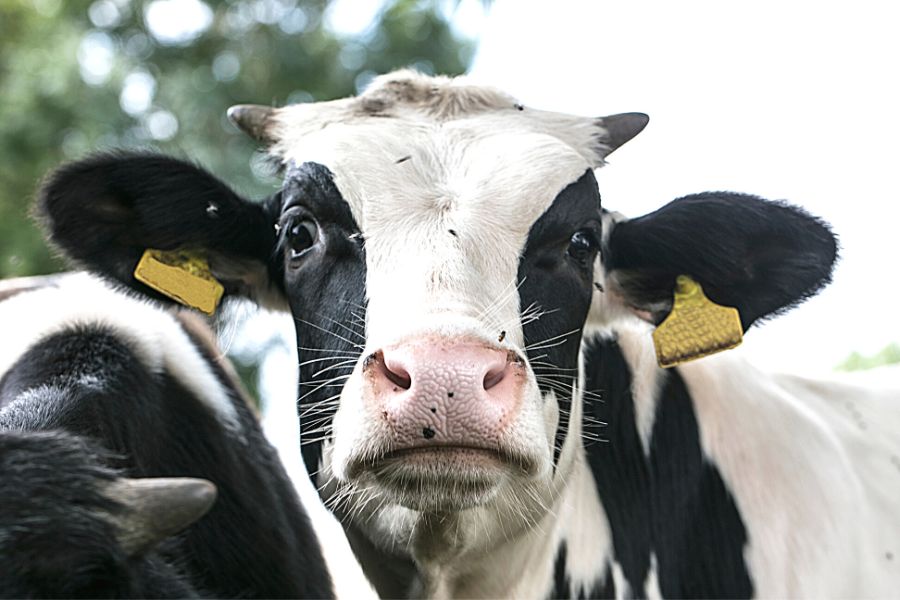Pests such as flies are an incredible nuisance for cows and farmers. They irritate the animals, cause weight loss, and carry disease. There are many different fly control methods, but one of the most popular is cattle fly tags. An important question to answer is how long ear fly tags last on cattle.
Fly tags provide long-term insecticidal control of flies on cattle. Most tags are designed to last twelve to sixteen weeks, but different brands have varying duration. Climate and the number of tags attached to the cow influences the effectiveness and duration of the ear tag insecticide.
Dairy farmers must have a thorough knowledge of the insecticide products used on their cattle. Monitoring and controlling flies on animals is part of good cow husbandry.
How Long Do Cattle Fly Tags Last?

Fly tags are a long-term fly control method. They are popular with farmers because they last a long time, minimizing the number of times a farmer must handle his cattle for fly and tick control.
Most cattle fly tags are designed to last twelve to sixteen weeks. A Kansas state veterinarian entomologist cautions that cattle fly tags do not usually last as long as the manufacturers claim.
Different brands of cattle fly tags are effective for varying periods.
Brand Of Cattle Fly Tag | Length Of Time |
|---|---|
Flectron Fly Tags | 16 weeks |
20 weeks | |
Double Barrel VP | 20 weeks |
20 weeks | |
Python Insecticide Cattle Ear Tags | 12 to 16 weeks |
20 weeks | |
XP820TM | 20 weeks |
Optimizer | 20 weeks |
How Do You Know When Fly Ear Tags Need Replacing?
Fly ear tags have a limited life span. Although manufacturers claim the fly tags are effective for a set period, they may not last as long as it is claimed.
Entomologists recommend counting flies on cattle to determine when new tags are needed. The University of Wisconsin recommends fitting or replacing ear tags when fifty flies land cow’s one side. Some researchers and farmers put on fly tags when fly numbers reach one hundred to two hundred flies on an animal’s side.
If cattle fly tags fall off, they need to be replaced. Sometimes cattle rub their heads on fence posts, bushes, or tree trunks. This can lead to the fly tag loosening and falling off.
What Makes Cattle Fly Tags More Effective For Longer?
Cattle ear fly tags are impregnated with insecticide. The tags are hooked into the cow's ears. As the cow turns, the insecticide is wiped off onto the cow's coat.
Does The Number Of Fly Tags Per Cow Make A Difference?
Many farmers use only one tag per animal, but this may not effectively diminish the number of flies biting the cattle. Most products recommend using a fly tag in each ear. This spreads the insecticide more easily to both sides of the body.
Manufacturers claim that using two ear tags per animal is not only more effective but lasts longer. For example, Python Fly Tags last three to four months with one tag but four to five months with two tags.
Veterinary entomologists agree with this recommendation but remind farmers to use ear tags cautiously on calves less than three months old. The manufacturer’s instructions must be carefully followed when using ear tags with calves. Two ear tags may constitute an overdose and be detrimental to the calf.
Does The Fly Tag Active Ingredient Make A Difference?
Cattle fly tags use one of three active ingredients as an insecticide. The three classes of insecticides are:
- Organophosphates
- Ivermectin
- Pyrethroids
Each class of insecticide is effective, but flies and other nuisance parasites can build up immunity if one product is continuously used. Experts recommend that the class of insecticide is changed every year. For example, in year one, the farmer uses organophosphates; in year two, ivermectin; and in year three, pyrethroids.
Changing the class of insecticide prevents pests from adapting to survive a particular insecticide. The tags should be removed after twelve to twenty weeks when they have stopped being effective.
Old tags still release tiny amounts of insecticide. The flies and ticks in the area are exposed to these non-lethal quantities and develop resistance to the poison.
Not all products are suitable for calves. It is essential to determine which products are suitable to alternate on calves. Try to match the class of insecticide for calves with the product used on the rest of the herd.
Only certain ear fly tags are approved for use on dairy cattle. This factor must be considered when alternating active ingredients on a dairy herd.
Cow Fly Ear Tags Have Variable Species Effectiveness
Cow Ear Fly Tag manufacturers claim efficacy for a certain period, but this may not be true for all pest species. For example, a product may repel flies for five months but only be effective against ticks for seven to eight weeks.
Horn flies, stable flies, midges, and face flies may react differently to an insecticide. The fly tag may be effective for one species for four months but only repel or kill another for six weeks.
Does Climate Affect Cow Ear Fly Tags?
Cow ear fly tags are made to be climate resistant, but in extreme weather, they will probably fail earlier than expected. Torrential downpours and continuous rain can make the ear tags less effective or shorten the time they are effective.
Fly tags are not influenced by the temperature and will remain effective in cold and hot weather. Generally, fly tags are not used through the winter as the fly population dies down.
Conclusion
Ear fly tags may be effective, but some farmers are not happy using them on their cattle for various reasons. There are many other alternatives to ear tags. Pour-on remedies are quicker to apply and are usually poured along the length of the back, protecting the cow’s whole body from pests. Sprays, dips, powders, dust bags, and oral medication can also be used instead of ear fly tags.
Sources:
DOMINATOR® INSECTICIDE EAR TAGS | Merck Animal Health USA
Python™ Insecticide Cattle Ear Tag | Santa Cruz Animal Health
double barrel ® vp insecticide ear tags - Cattle
Corathon® Insecticide Cattle Ear Tags (organophosphate)
XP-820™ Insecticide Cattle Ear Tag | Santa Cruz Animal Health
Optimizer Insecticide Cattle Ear Tags Y-Tex - Fly Tags | Cattle Fly Lice | Farm
